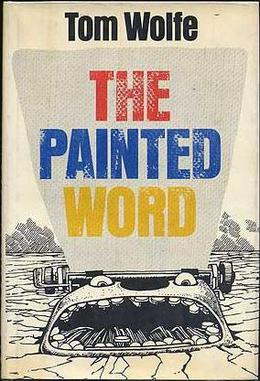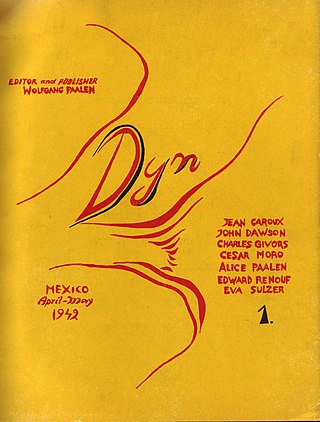
Modernism is a philosophical, religious, and arts movement that arose from broad transformations in Western society during the late 19th and early 20th centuries. The movement reflected a desire for the creation of new forms of art, philosophy, and social organization which reflected the newly emerging industrial world, including features such as urbanization, architecture, new technologies, and war. Artists attempted to depart from traditional forms of art, which they considered outdated or obsolete. The poet Ezra Pound's 1934 injunction to "Make it New" was the touchstone of the movement's approach.

In the arts and in literature, the term avant-garde identifies a genre of art, an experimental work of art, and the experimental artist who created the work of art, which usually is aesthetically innovative, whilst initially being ideologically unacceptable to the artistic establishment of the time. The military metaphor of an advance guard identifies the artists and writers whose innovations in style, form, and subject-matter challenge the artistic and aesthetic validity of the established forms of art and the literary traditions of their time; thus how the artists who created the anti-novel and Surrealism were ahead of their times.

Kitsch is a term applied to art and design that is perceived as naïve imitation, overly eccentric, gratuitous or of banal taste.

Clement Greenberg, occasionally writing under the pseudonym K. Hardesh, was an American essayist known mainly as an art critic closely associated with American modern art of the mid-20th century and a formalist aesthetician. He is best remembered for his association with the art movement abstract expressionism and the painter Jackson Pollock.

Postmodern art is a body of art movements that sought to contradict some aspects of modernism or some aspects that emerged or developed in its aftermath. In general, movements such as intermedia, installation art, conceptual art and multimedia, particularly involving video are described as postmodern.

Jean Philippe Arthur Dubuffet was a French painter and sculptor. His idealistic approach to aesthetics embraced so-called "low art" and eschewed traditional standards of beauty in favor of what he believed to be a more authentic and humanistic approach to image-making. He is perhaps best known for founding the art movement art brut, and for the collection of works—Collection de l'art brut—that this movement spawned. Dubuffet enjoyed a prolific art career, both in France and in America, and was featured in many exhibitions throughout his lifetime.

Partisan Review (PR) was a left-wing small-circulation quarterly "little magazine" dealing with literature, politics, and cultural commentary published in New York City. The magazine was launched in 1934 by the Communist Party USA–affiliated John Reed Club of New York and was initially part of the Communist political orbit. Growing disaffection on the part of PR's primary editors began to make itself felt, and the magazine abruptly suspended publication in the fall of 1936. When the magazine reemerged late in 1937, it came with additional editors and new writers who advanced a political line deeply critical of Joseph Stalin's Soviet Union.
Simon Webster Frith is a British sociomusicologist and former rock critic who specializes in popular music culture. He is Professor Emeritus of Music at University of Edinburgh.
The term middlebrow describes middlebrow art, which is easily accessible art, usually popular literature, and middlebrow people who use the arts to acquire the social capital of "culture and class" and thus a good reputation. First used in the British satire magazine Punch in 1925, the term middlebrow is the intellectual, intermediary brow between the highbrow and the lowbrow forms of culture; the terms highbrow and lowbrow are borrowed from the pseudoscience of phrenology.

Hans Hofmann was a German-born American painter, renowned as both an artist and teacher. His career spanned two generations and two continents, and is considered to have both preceded and influenced Abstract Expressionism. Born and educated near Munich, he was active in the early twentieth-century European avant-garde and brought a deep understanding and synthesis of Symbolism, Neo-impressionism, Fauvism, and Cubism when he emigrated to the United States in 1932. Hofmann's painting is characterized by its rigorous concern with pictorial structure and unity, spatial illusionism, and use of bold color for expressive means. The influential critic Clement Greenberg considered Hofmann's first New York solo show at Peggy Guggenheim’s Art of This Century in 1944 as a breakthrough in painterly versus geometric abstraction that heralded abstract expressionism. In the decade that followed, Hofmann's recognition grew through numerous exhibitions, notably at the Kootz Gallery, culminating in major retrospectives at the Whitney Museum of American Art (1957) and Museum of Modern Art (1963), which traveled to venues throughout the United States, South America, and Europe. His works are in the permanent collections of major museums around the world, including the Metropolitan Museum of Art, Tate Modern, Germanisches Nationalmuseum, National Gallery of Art, and Art Institute of Chicago.
Paracinema is an academic term to refer to a wide variety of film genres out of the mainstream, bearing the same relationship to 'legitimate' film as paraliterature like comic books and pulp fiction bears to literature.
Leo Steinberg was an American art critic and art historian.

Reply of the Zaporozhian Cossacks is a painting by Ilya Repin. It is also known as Cossacks of Saporog Are Drafting a Manifesto and Cossacks are Writing a Letter to the Turkish Sultan.

The 9th Street Art Exhibition of Paintings and Sculpture is the official title artist Franz Kline hand-lettered onto the poster he designed for the Ninth Street Show. Now considered historic, the artist-led exhibition marked the formal debut of Abstract Expressionism, and the first American art movement with international influence. The School of Paris, long the headquarters of the global art market, typically launched new movements, so there was both financial and cultural fall-out when all the excitement was suddenly emanating from New York. The post-war New York avant-garde, artists like Willem de Kooning and Jackson Pollock, would soon become "art stars," commanding large sums and international attention. The Ninth Street Show marked their "stepping-out," and that of nearly 75 other artists, including Harry Jackson, Helen Frankenthaler, Joan Mitchell, Grace Hartigan, Robert De Niro Sr., Philip Guston, Elaine de Kooning, Lee Krasner, Franz Kline, Ad Reinhardt, David Smith, Milton Resnick, Joop Sanders, Robert Motherwell, Barnett Newman and many others who were then mostly unknown to an art establishment that ignored experimental art without a ready market.
In the visual arts, late modernism encompasses the overall production of most recent art made between the aftermath of World War II and the early years of the 21st century. The terminology often points to similarities between late modernism and post-modernism although there are differences. The predominant term for art produced since the 1950s is contemporary art. Not all art labelled as contemporary art is modernist or post-modern, and the broader term encompasses both artists who continue to work in modern and late modernist traditions, as well as artists who reject modernism for post-modernism or other reasons. Arthur Danto argues explicitly in After the End of Art that contemporaneity was the broader term, and that postmodern objects represent a subsector of the contemporary movement which replaced modernity and modernism, while other notable critics: Hilton Kramer, Robert C. Morgan, Kirk Varnedoe, Jean-François Lyotard and others have argued that postmodern objects are at best relative to modernist works.

The Painted Word is a 1975 book of art criticism by Tom Wolfe.

DYN was an art magazine founded by the Austrian-Mexican Surrealist Wolfgang Paalen, published in Mexico City, and distributed in New York City, and London between 1942 and 1944. Only six issues were produced.

Art history is the study of aesthetic objects and visual expression in historical and stylistic context. Traditionally, the discipline of art history emphasized painting, drawing, sculpture, architecture, ceramics and decorative arts; yet today, art history examines broader aspects of visual culture, including the various visual and conceptual outcomes related to an ever-evolving definition of art. Art history encompasses the study of objects created by different cultures around the world and throughout history that convey meaning, importance or serve usefulness primarily through visual representations.
Avant-garde art and American pop culture have had an intriguing relationship from the time of the art form's inception in America to the current day. The art form, which began in the early half of the nineteenth century in Europe, started to rise slowly in America under the guise of Dadaism in 1915. While originally formed under a group of artists in New York City who wanted to counter pop culture with their art, music, and literature the art form began to grow into prominence with American pop culture due to a variety of factors between the 1940s to the 1970s. However, from many factors that arose in the late 1970s, avant-garde began to both lessen in prominence and began to blend with the pop culture to the point in which most art critics considered the art form extinct.

The Khrushchev Thaw is the period from the mid-1950s to the mid-1960s when repression and censorship in the Soviet Union were relaxed due to Nikita Khrushchev's policies of de-Stalinization and peaceful coexistence with other nations. The term was coined after Ilya Ehrenburg's 1954 novel The Thaw ("Оттепель"), sensational for its time.













